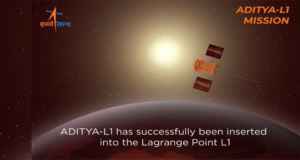 Bengaluru: In a remarkable achievement, the Indian Space Research Organisation (ISRO) has successfully entered the Aditya L1 satellite into its final orbit. This significant milestone marks India’s first mission dedicated to the study of the sun, and it has been positioned at Lagrange Point 1 (L1), according to ISRO officials.
Bengaluru: In a remarkable achievement, the Indian Space Research Organisation (ISRO) has successfully entered the Aditya L1 satellite into its final orbit. This significant milestone marks India’s first mission dedicated to the study of the sun, and it has been positioned at Lagrange Point 1 (L1), according to ISRO officials.
In a social media announcement, ISRO shared the news that Aditya L1 has successfully entered the Halo orbit around the L1 point.
This task was considered one of the most challenging aspects of the mission, as it required precise maneuvering of the satellite to achieve this specific orbit, situated approximately 1.5 million kilometers away from Earth.
To accomplish this feat, ISRO utilized the motor and thrusters from the Ground Command Centre. The spacecraft’s propulsion system, which includes a 440 Newton Liquid Apogee Motor, eight 22 Newton thrusters, and four 10 Newton thrusters, was employed intermittently to navigate the satellite to its designated L1 point.
ISRO stated, “Halo-Orbit Insertion (HOI) of its solar observatory spacecraft, Aditya-L1 was accomplished at 16.00 Hrs (approx) on January 6, 2024 (IST). The final phase of the maneuver involved firing of control engines for a short duration.”
The Aditya-L1 spacecraft will follow a periodic Halo orbit, located approximately 1.5 million kilometers from Earth along the Sun-Earth line. This orbit has an orbital period of approximately 177.86 Earth days and involves three-dimensional motion in relation to the Sun, Earth, and the spacecraft.
This specific Halo orbit was chosen to ensure a mission lifespan of five years, minimizing the need for station-keeping maneuvers and conserving fuel. It also provides a continuous, unobstructed view of the sun, crucial for solar observations.
Prime Minister of India, Narendra Modi hailed this achievement as a “landmark” and commended the dedication of ISRO scientists.
He stated, “India creates yet another landmark. India’s first solar observatory Aditya-L1 reaches its destination. It is a testament to the relentless dedication of our scientists in realizing one of the most complex and intricate space missions.”
President Droupadi Murmu praised ISRO for this remarkable feat, emphasizing the significant participation of women scientists in ISRO missions, which contributes to women’s empowerment.
The Aditya-L1 mission is designed to observe and understand the dynamics of the sun’s chromosphere and corona continuously. Placing the satellite in a halo orbit around the L1 point offers advantages such as smooth sun-spacecraft velocity changes, sampling of the solar wind and particles, and uninterrupted sun observation.
The complex halo orbit insertion process was meticulously executed by ISRO, showcasing its capabilities in precise orbital maneuvers.
This success not only underscores ISRO’s expertise but also instills confidence in handling future interplanetary missions.



